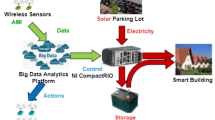Abstract
Cognitive radio technologies permit the sharing of spectrums between unlicensed as well as licensed customers, based on the principle of non-interference. Spectrum sensing, in this field, is hence a vital tool that assists in the ascertainment of availability of a particular channel within the licensed spectrum, for unlicensed customers. But this function uses significant power that could be lessened through the employment of predictive mechanisms to discover spectrum holes. The traffic features of licensed customer systems in the real world are not known beforehand. In this paper, a spectrum predictor based on Neural Networks model Multi-Layer Perceptron and Back Propagation that do not need prior information regarding traffic features of licensed customers is designed. Binary Shuffled Frog Leaping Algorithm is proposed for structure optimization, the binary structure is suggested to show the memes with the purpose of developing a sub-collection with lesser dimensions than that of the original collection where detecting sensitivity and accuracy would be scalable with that of the primary status. Spectrum Predictor’s performance is examined through exhaustive experiments.





Similar content being viewed by others
References
Venkatesan, M., & Kulkarni, A. V. (2014). Spectrum predictor model for cognitive radio. In International conference on advances in engineering & technology (ICAET) (pp. 10–14).
Marinho, J., Granjal, J., & Monteiro, E. (2015). A survey on security attacks and countermeasures with primary user detection in cognitive radio networks. EURASIP Journal on Information Security, 2015(1), 1–14.
Sadough, S. S., & Ivrigh, S. S. (2012). Spectrum sensing for cognitive radio systems through primary user activity prediction. Radioengineering, 21(4), 1092–1100.
Roy, P., & Muralidhar, M. (2015). Channel state prediction in a cognitive radio network using neural network Levenberg-Marquardt algorithm. International Journal of Wireless Communications and Networking Technologies, 4(2), 24–29.
López-Benítez, M. (2014). Sensing-based spectrum awareness in Cognitive Radio: Challenges and open research problems. In 2014 9th international symposium on communication systems, networks & digital signal processing (CSNDSP) (pp. 459–464).
Xing, X., Jing, T., Cheng, W., Huo, Y., Cheng, X., & Znati, T. (2014). Cooperative spectrum prediction in multi-PU multi-SU cognitive radio networks. Mobile Networks and Applications, 19(4), 502–511.
Pulakka, H., & Alku, P. (2011). Bandwidth extension of telephone speech using a neural network and a filter bank implementation for highbandmel spectrum. IEEE Transactions on Audio, Speech, and Language Processing, 19(7), 2170–2183.
Black, T., Kerans, B., & Kerans, A. (2012). Implementation of hidden Markov model spectrum prediction algorithm. In 2012 international symposium on communications and information technologies (ISCIT) (pp. 280–283).
López-Benítez, M., & Casadevall, F. (2011). Discrete-time spectrum occupancy model based on markov chain and duty cycle models. In 2011 IEEE symposium on new frontiers in dynamic spectrum access networks (DySPAN) (pp. 90–99).
Tumuluru, V. K., Wang, P., & Niyato, D. (2010). A neural network based spectrum prediction scheme for cognitive radio. In 2010 IEEE international conference on communications (ICC) (pp. 1–5).
Najashi, B. G., Wenjiang, F., & Almustapha, M. D. (2014). Spectrum hole prediction based on historical data: A neural network approach. arXiv preprint arXiv:1401.0886.
Agarwal, P., & Mehta, S. (2014). Nature-inspired algorithms: State-of-art, problems and prospects. International Journal of Computer Applications, 100(14), 14–21.
Afzalan, E., Taghikhani, M. A., & Sedighizadeh, M. (2012). Optimal placement and sizing of dg in radial distribution networks using sfla. International Journal of Energy Engineering, 2(3), 73–77.
Author information
Authors and Affiliations
Corresponding author
Rights and permissions
About this article
Cite this article
Supraja, P., Jayashri, S. Optimized Neural Network for Spectrum Prediction Scheme in Cognitive Radio. Wireless Pers Commun 94, 2597–2611 (2017). https://doi.org/10.1007/s11277-016-3818-3
Published:
Issue Date:
DOI: https://doi.org/10.1007/s11277-016-3818-3




